CONFIRMED: Wallabies land final piece of coaching puzzle as ex-Lion signs on ahead of showpiece event
Four years after getting a taste of international coaching, Geoff Parling will return as the Wallabies’ new lineout coach. The Roar can reveal the…
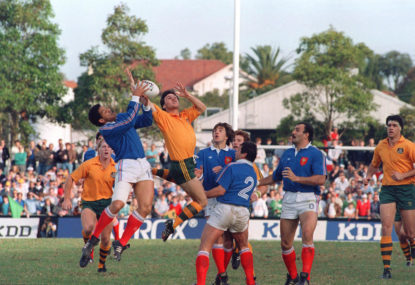
The 1987 Rugby World Cup semi-final, contested between France and Australia at Concord Oval in Sydney on June 13 1987, is one of the greatest Tests of rugby union in history.
It is the greatest game of rugby union from the 1980s.
Several records were broken during this match.
David Campese broke Scottish winger Ian Smith’s 54-year-old record for most international Test tries, when he scored his 25th try.
Michael Lynagh overtook Paul McLean’s record of 263 for most points scored by an Australian at Test level, finishing the match with 269 points.
Pierre Berbizier played his 34th Test for France, becoming the most capped scrum-half in French rugby history, overtaking his coach Jacques Fouroux.
Philippe Sella became France’s leading try scorer in international Test match rugby with 19 when he scored just after half-time.
When Serge Blanco scored the Test-winning try in the final stages of injury time, he equaled Sella’s record of 19 for most tries scored by a French player.
The lead changed five times in the second half of the match and the play moved from one end of the field to the other.
“It was a contest that would often afterwards be described by rugby aficionados as ‘the game of the century’”, Peter FitzSimons would later recall. (FitzSimons: 1993, 150)
Andrew Slack would later add that “it was without doubt the highlight of the tournament…” (Slack: 1995, 130)
French centre Philippe Sella, the first rugby player to play in 100 international Tests, called it the greatest Test he ever played. (Lynagh and Eglinton: 2015, 56)
Michael Lynagh regards the match one of the finest in which he has played (Slack: 1995, 130) and one of the greatest Test matches ever played. (Lynagh and Eglinton: 2015, 56)
“…it was a great game of rugby, one of the very best in which I have ever played,” David Campese would later recall in On a Wing and a Prayer.
“Sensational things, like brilliant scores, started to happen in that game and we just carried on from there.” (Campese and Bills: 1991, 142)
“That semi-final has been described as one of the finest games in the history of rugby football,” Simon Poidevin asserted in For Love Not Money.
“It had everything. Power, aggression, skills, finesse, speed, atmosphere and reams of excitement.” (Poidevin and Webster: 1991, 148)
France
15. Serge Blanco
14. Didier Camberabero
13. Philippe Sella
12. Denis Charvet
11. Patrice Lagisquet
10. Franck Mesnel
9. Pierre Berbizier
8. Laurent Rodriguez
7. Dominique Erbani
6. Éric Champ
5. Jean Condom
4. Alain Lorieux
3. Jean-Pierre Garuet-Lempirou
2. Daniel Dubroca (c)
1. Pascal Ondarts
Coach: Jacques Fouroux
This was not the same French side that lost to Australia 14-27 in an Australian forwards’ demolition in 1986. Absent from the 1986 French side were Ondarts, Garuet, Lorieux, Condom, Erbani, Mesnel and Camberabero.
The French team contained the same backline that won the 1987 Five Nations title, along with the grand slam of rugby union, with one exception. Didier Camberabero was selected on the wing, giving France a specialist goal-kicker, replacing the absent Jean-Baptiste Lafond.
The most detectable improvement in this French side, compared to the 1986 French touring side, was notable in their tight five.
France’s then-most capped second-rower Jean Condom was not chosen to play in 1986, while Alain Lorieux was emerging in 1987 as what Bill McLaren described as “the form lock in world rugby.”
Perhaps the most important additions to the French side were the inclusions of two world-class props in Jean-Pierre Garuet at tighthead prop and Pascal Ondarts at loosehead prop.
Poidevin once wrote of Garuet that he “looks like your friendly Lourdes greengrocer with his droopy moustache and warm smile, but is as about as friendly as a mating rhinoceros.” (Poidevin and Webster: 1991, 147)
Australia
15. David Campese
14. Peter Grigg
13. Andrew Slack (c)
12. Brett Papworth
11. Matthew Burke
10. Michael Lynagh
9. Nicholas Farr-Jones
8. Troy Coker
7. Jeffrey Miller
6. Simon Poidevin
5. William Campbell
4. Steven Cutler
3. Andrew MacIntyre
2. Tom Lawton Jr
1. Cameron Lillicrap
Replacements
17. Anthony Herbert (12th minute)
19. David Codey (22nd minute)
Coach: Alan Jones
David Campese continued to substitute for the injury-prone Roger Gould at fullback.
Gould hurt himself during the first World Cup pool match against England, leaving the game with a groin complaint.
Campese himself was under an injury cloud and played throughout the tournament with a hematoma in his left leg and a then undetected bone in his ankle split in half. (Campese: 2003, 168)
Wallaby halfback Nick Farr-Jones entered into the match with a shoulder injury he sustained in the first minute of the quarter-final match against Ireland, when Irish flanker Phil Matthews made high late contact with Farr-Jones following a kick. (FitzSimons: 1993, 150)
In the forwards, Troy Coker was selected at eightman in what Andrew Slack later called “a controversial choice ahead of David Codey.” (Slack: 1995, 129)
While Jones’ selection of Coker ahead of Codey drew the ire of some, the merit of this decision could not be assessed, as an injury to Bill Campbell in the 21st minute of the semi-final forced Troy Coker to move to the second-row, so David Codey could play at eightman.
Perhaps the most controversial omission from the Australian side was the continued non-selection of Enrique “Topo” Rodriguez.
Philip Derriman, in The Rise and Rise of Australian Rugby, documented that, “Rodriguez believes this may have been because he was taking anti-inflammatory drugs for an injury and wasn’t considered fully fit.” (Derriman: 2003, 154)
In For Love Not Money, Simon Poidevin recalled how the astute French coach Jacques Fouroux later told the Wallabies that when Rodriguez wasn’t selected, he felt confident of victory because France’s scrum would be able to take control of the Australian pack. (Poidevin and Webster: 1992, 147)
Michael Lynagh opened the scoring in this semi-final with a drop-goal in the fifth minute of play.
Campbell obtained clean possession for the Wallabies in a line-out, and although Farr-Jones’ pass to Lynagh was uncharacteristically high, Lynagh was able to snatch the ball and kick a slightly wobbly drop-goal.
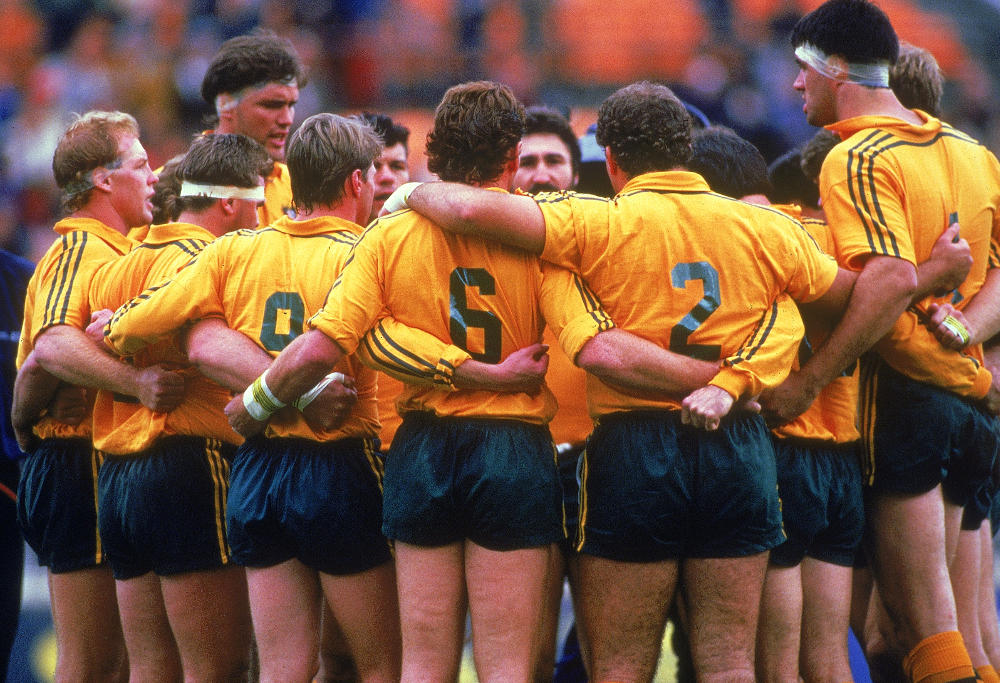
The Wallabies stand in a group huddle. (Photo by Getty Images)
Watching the height of Farr-Jones’ pass, I wonder whether he had completely recovered from his shoulder injury from the following week.
It was a tremendous kick, however, because Lynagh was almost on the run and landed the drop-goal from outside France’s quarter.
However, ominous signs began to appear for Australia with the second scrum of the Test.
“In the opening scrum of the semi-final, we noticed a marked difference,” (Poidevin and Webster: 1991, 147) Simon Poidevin would later remember.
“No sooner did the packs come together for that first scrum than we felt this huge surge of power coming through on us.”
“Hang on, what’s this? Our scrum hadn’t been moved for three years. What’s the story here? Psychologically, the French immediately had the upper hand on us.” (Poidevin and Webster: 1991, 148)
A further watershed moment for the Wallabies would occur in the eighth minute of the Test.
Brett Papworth had been arguably Australia’s outstanding back of the 1987 Rugby World Cup.
Papworth ran the ball up, making gains over the advantage line. However, as a maul formed around him, the French second-rower Jean Condom deliberately collapsed it.
The Scottish referee Brian Anderson correctly awarded the penalty to Australia for Condom’s error. However, as the bodies began clearing away from the collapsed maul, there Papworth could be seen lying on the ground clutching his knee.
Papworth hobbled away, still intent on continuing the game.
Lynagh converted the penalty in the ninth minute, just outside the French 22 and on a slight angle, to make the score 6-0.
Condom’s error cost France three points, but it cost Australia more than that.
As Didier Camberabero prepared to restart play with the kick-off, there Papworth lay in the backfield unable to stand on his feet.
He left the field in the 11th minute with medial ligament damage.
In his place on the bench was Anthony Herbert of the Wests Club in Brisbane. By replacing Papworth, Herbert earned his second cap for Australia.
Controversy ensued in the 14th minute of the game when Nick Farr-Jones was penalised for a high tackle on French flyhalf Franck Mesnel.
The ball had come to French flanker Dominique Erbani, who had a clear path to the Australian try-line. However, referee Brian Anderson sought not play the advantage.
Footage of the Test shows a disgruntled French coach Jacques Fouroux and replacement hooker Philippe Dintrans in the stands, reacting to what they felt was the wrong decision.
French goal-kicker Didier Camberabero missed the penalty in the 15th minute when the ball passed the left upright post to keep the score 6-0 in Australia’s favour.
A second devastating moment came for the Wallabies in the 19th minute when Bill Campbell suffered what was Australia’s second medial ligament injury.
While Daniel Dubroca was performing the sweeping duties around the French line-out, he fell on Campbell’s leg, bending it in the wrong direction.
Like Papworth, Campbell attempted to continue playing. However, following the next line-out is was obvious that he would be unable to compete for the rest of the match.
Campbell left the field after 21 minutes of play to be replaced by David Codey in the 22nd minute.
Campbell’s injury now forced Troy Coker to move to the second row and be Australia’s number two jumper in the line-out.
[latest_videos_strip category=”rugby” name=”Rugby”]
During the 24th minute of the match, Michael Lynagh attempted a second field-goal. However, Champ and Mesnel were ready for it, and Mesnel smothered the ball. Charvet then booted the ball downfield into Australian territory.
Anthony Herbert tried to recover the ball, but was penalised just inside Australia’s half for not releasing the ball in the 25th minute.
Camberabero missed his second penalty kick (a long-range attempt) in the 26th minute. The score remained at 6-0.
An ill-disciplined mistake from Pierre Berbizier cost France in the 29th minute of the game, when following another powerful French scrum, he was penalised for trying to pick the ball up from an offside position.
Lynagh converted the penalty with a phenomenal kick just inside Australian territory, on a slight angle, in the 30th minute of the Test, giving Australia a 9-0 lead.
Incredibly, for all their dominance, France was yet the score a point in the game.
During the 38th minute of play, French second-rower Jean Condom was penalised for the second time in the first-half for a ruck infringement.
The easiest penalty kick Lynagh had in the first half was in the 39th minute. It was just outside the French 22 on a slight angle.
Success would give Lynagh the Australian record for most international Test points, surpassing Paul’s McLean’s record of 263 points.
It would also grant Australia a likely 12-0 lead going into half-time.
Lynagh missed the kick, leaving the score at 9-0 to Australia’s advantage.
With 40 minutes expired and injury time almost up, France launched one final attack that took them to about one metre from Australia’s try-line.
Blanco injected himself into the movement and appeared to have made enough space for Didier Camberabero, when replacement centre Anthony Herbert made possibly the tackle of the match.
It was a magnificent desperate diving tackle-attempt, and it forced the ball into touch with little time left in the first half.
It was moments before half-time. Australia’s scrum had been dominated and at times destroyed. France had played much of the creative attacking rugby of the first half. Yet incredibly Australia held a 9-0 lead.
If Australia could hold onto that lead and keep France scoreless, it would have been an enormous boost given the dominance of the French side.
Then perhaps the biggest watershed of the game happened.
Two minutes into injury time, Troy Coker won the ball at the front of the line-out. Coker was standing at two in the line-out, where Bill Campbell would have been had he not been injured earlier in the game.
As a maul formed around him, all the forwards from both sides tried to compete for the ball.
Unbeknownst to the forwards of both teams, Alain Lorieux had simply ripped the ball from Coker, peeled off the front of the line-out, and with his vastly superior height and weight, powered past Nick Farr-Jones down the blindside for the softest of tries.

David Campese of the Wallabies in action. (Photo by Getty Images)
Andrew Slack later wrote, “The French can get rattled when the pressure is on but that try gave them a sniff, and with the talent they had, the extra boost of confidence was all they needed.” (Slack: 1995, 130)
After missing two easier penalties in the first half, Didier Camberabero rediscovered his goal-kicking radar and converted Lorieux’s try from touch.
The score at half-time was Australia 9 – France 6.
France took the lead in the 44th minute of the Test with a Philippe Sella try, after brilliant lead-up work from French lock Alain Lorieux and scrumhalf Pierre Berbizier.
Sella simply changed the angle of his run and glided past Slack, Lynagh and Campese.
Camberabero converted the try in the 45th minute. France was ahead 12-9.
Philippe Sella’s try was the 19th of his Test career and gave him the record for most tries scored by a French player.
However, Lynagh would respond only a few moments later with a marvelous line-break.
After receiving the ball in the centre of the field, Lynagh stepped past his opposite flyhalf Frank Mesnel, and then stepped again, this time beating Pierre Berbizier who ran too far across in cover defence.
As the French defence began to swarm upon Lynagh, he hoisted a high floating pass to Peter Grigg on the wing. Before Grigg’s opposite winger Patrice Lagisquet could tackle him, he popped an inside ball to Campese, who had a clear run to the French try-line to score his world record breaking try in the 46th minute.
Campese’s 25th international Test try allowed him to surpass Scottish winger Ian Smith’s record of 24 that had stood since 1933!
As Lynagh lined up to kick the conversion, he noticed something.
“I was aware of this ball boy – probably twelve years old – still standing there. I looked up at him as if to say, “you shouldn’t still be there.”
He didn’t move.
“This is a pretty important kick, mate…”
“Thanks, I know,” I said. “This is the semi-final of the World Cup.”
“Well, you better get it,” he said, before trotting off.
“I did get it and as I was running back for the restart, I glanced over and saw him standing on the touchline giving me the thumbs-up with a big smile on his face. I’ll never forget it.” (Lynagh and Eglinton: 2015, 58-9)
Lynagh’s successful conversion in the 48th minute gave him the record for most points scored by an Australian with 264, after he passed Paul McLean’s record of 263.
However, Lynagh’s phenomenal achievement would be followed moments later by a desperate missed opportunity.
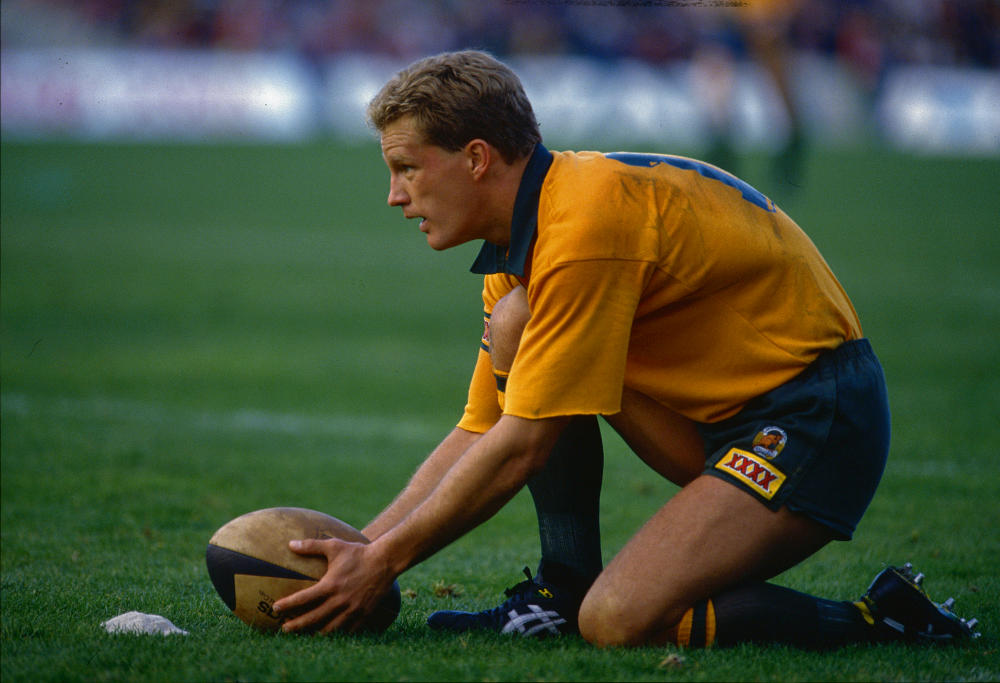
Lynagh was a reliable kick for the Wallabies. (Photo by Jerome Prevost/TempSport/Corbis/VCG via Getty Images)
France were penalised in the 50th minute for ‘hands in the ruck’, and Michael Lynagh had a penalty kick about 22 metres from the goal and on a slight angle.
A successful Lynagh kick would give Australia a 18-12 lead. The ball hit the right upright post in the 53rd minute.
He missed it.
Moments later, following this missed opportunity, France initiated a brilliant counterattack from quick turnover ball.
Berbizier passed to Charvet, and then Blanco injected himself into the counterattack.
Blanco’s elusive running was magnificent. Blanco ran in the direction of Australian winger Peter Grigg, and Grigg seemed uncertain as to whether to commit himself to tackling Blanco or worry about his opposite winger Lagisguet.
Campese, coming in from fullback, perhaps overcommitted himself by rushing-up to stop Blanco.
Blanco was able to swerve around Campese in the mud, and as Andrew Slack attempted to tackle him coming across in cover, Blanco offloaded the ball to Lagisquet.
Lagisquet then had a clear run to score France’s third try of the Test in the 54th minute, giving France the lead.
Camberabero converted Lagisquet’s try in the 56th minute to make the score 18-15 in France’s favour.
France increased their lead moments later, after the Australian centres were penalised in the 60th minute for rushing up in an offside position.
Camberabero kicked the penalty in the 61st minute, as the game entered its final quarter.
The score was 21-15 with France leading.
For a brief period it appeared as if the momentum belonged to France, yet amazingly David Codey responded with a try in the 64th minute.
Australia had a line-out almost on the French try-line.
Following the line-out, the ball appeared near the side of the French ruck, and David Codey had the simplest of tasks in merely picking the ball up, running less than five metres, and slamming it down for a try in the 64th minute.
This was a lucky try!
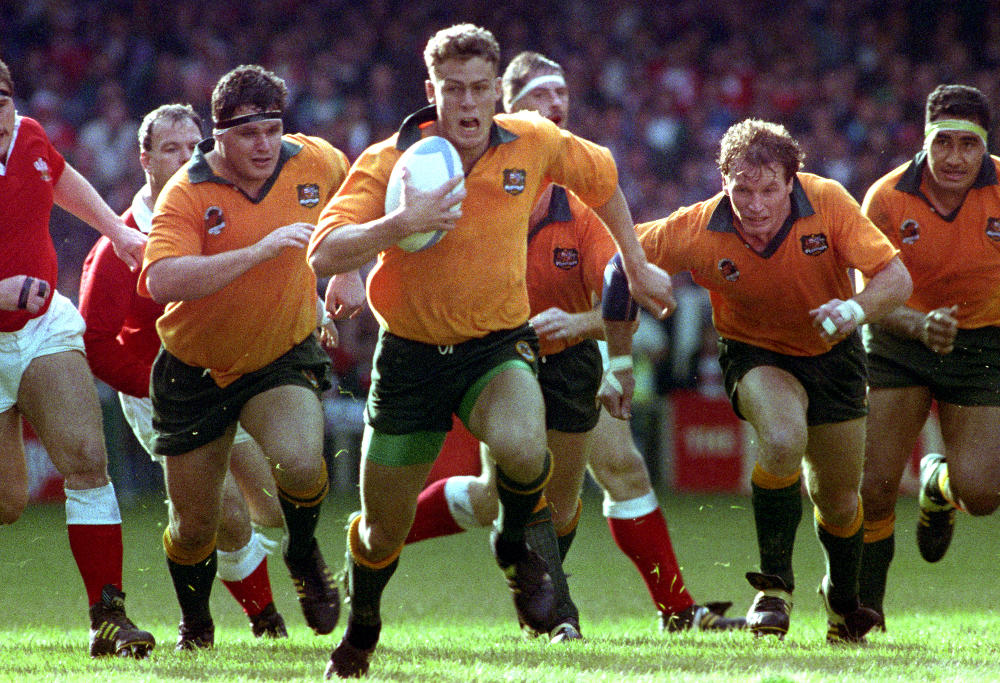
Simon Poidevin leads an Australian break-out. (Photo by Barry Batchelor – PA Images/PA Images via Getty Images)
One of the most powerful moments of the Test occurred after Codey’s try.
There in the foreground of Codey celebrating his try was the French centre Denis Charvet, hands on his head and collapsing to his knees in a moment of despair and disappointment.
Lynagh converted Codey’s try as the Test entered the 66th minute.
The scores were level at 21-21 with less than 15 minutes remaining in the game.
Australia would regain the lead, once again, with minutes remaining in the game.
Éric Champ was penalised for entering the side of the ruck and Australia were awarded a penalty in the 77th minute of play almost directly in front of the goals and only about five metres from the French try-line.
Lynagh kicked the penalty in the 78th minute, and with a little more than two minutes remaining in the match, Australia led France 24-21. However, due to several stoppages in the second half, there would be much injury-time played after regular time expired.
Australia should have finished off the game and won it.
France got the ball out to their backs and as far as their wing Didier Camberabero.
With nowhere to go, Camberabero had to kick the ball and his “up and under” went too far to concern Campese at fullback.
However, after Camberabero kicked the ball a horrible moment of ill-disciple from Anthony Herbert cost Australia three points.
Herbert caught Camberabero late and high after he kicked the ball. It was completely unnecessary. The Wallaby defensive line had kept the French at bay.
Instead, a penalty was awarded to France in the 80th minute with seconds remaining in the game, which Didier Camberabero kicked as the game entered the second minute of injury time.
Australia had a line-out in the French 22 with moments remaining in the Test.
Clean quick ball from the line-out and a drop-goal from Michael Lynagh would win the game and send Australia into the World Cup final to be played against New Zealand in Auckland.
The Wallabies couldn’t win quick possession. Farr-Jones tried to find Lynagh for the drop-goal, but he had Éric Champ bearing down on him.
The ball came to David Codey, but as he was tackled by Philippe Sella and laid the ball back, Sella carefully positioned his body to seal the ball off from the Australians.
France won the ruck ball and from there the ball went from Berbizier to Blanco to Lagisquet on the wing. Lagisquet was forced to kick the ball downfield.
David Campese at fullback allowed the ball to bounce.
What happened then has been scripted into folklore as one of the most famous movements in rugby union history.
Anthony Herbert tried to field the ball, but Alain Lorieux, streaming through the midfield, got in his way.
The ball came to Dominique Erbani who popped the ball up to Champ. Champ was dragged down to the ground by Coker, but not before he hoisted a high pass that was collected by Ondarts. Ondarts ran into Coker and laid the ball back.
Patrice Lagisguet picked up the ball and handed it onto Garuet down the blindside.
Garuet passed it to Rodriguez, who relayed the ball to Charvet.
Charvet was caught in a half-tackle by David Campese, who tried to drag him to the ground. Incredibly, Charvet was able to keep the ball alive and find Berbizier.
Berbizier then transferred play to the openside with a magnificent long pass to Lagisuqet.
Australia’s defence was now in a state of panic. They had overcompensated by committing too many players to the blindside.
The Wallabies began missing tackles. Slack tried snatching at Lagisquet, who ran on his inside, before he was brought down by Codey. Lagisquet lofted the ball in the air.
Michael Lynagh and Éric Champ both contested the ball.
Neither Lynagh nor Champ gathered the ball. It fell to Laurent Rodriguez who, before giving the Test-winning pass to the try-scoring Serge Blanco, slightly knocked the ball on.
Five minutes into injury time and with two minutes remaining in the game, Serge Blanco took the pass from Laurent Rodriguez and headed-off to the try-line.
It fell to Australian hooker Tom Lawton to attempt to make the try-saving tackle on Blanco in the corner.
Blanco slid over the line for what was the Test-winning try.
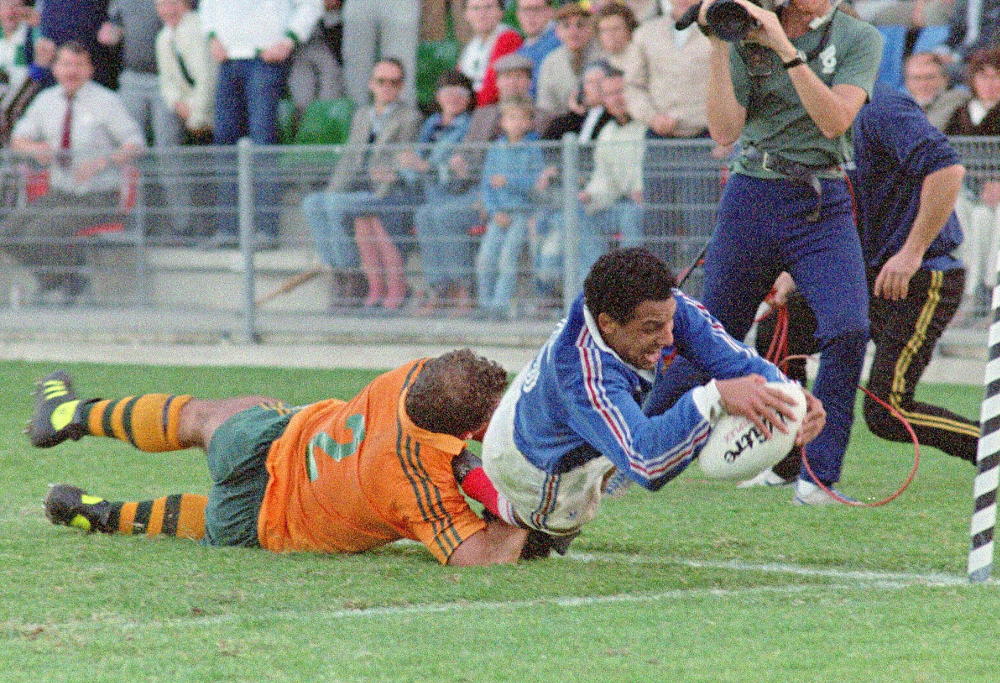
French fullback Serge Blanco dives in to score the winning try as Australian hooker Thomas Lawton tackles him in vain. (GEORGES GOBET/AFP/Getty Images)
However, it is questionable whether Lawton tackled Blanco into touch.
Years later Michael Lynagh would describe Blanco’s try as “suspect”.
“…back in 1987 the corner flag was considered to be ‘out’,” Lynagh would later write. “Tommy definitely had most of Blanco in touch before the ball went down.” (Lynagh and Eglinton: 2015, 56)
Didier Camberabero converted Blanco’s try from touch in the seventh minute of injury time.
Australia quickly restarted play, but after France kicked the ball into touch, there wasn’t enough time for one more line-out.
France had won one of the greatest matches in rugby union history.
Full-Time: France 30 – Australia 24
| Event | Score | Time |
| Lynagh drop-goal | 0-3 | 5th minute |
| Lynagh penalty goal | 0-6 | 9th minute |
| Lynagh penalty goal | 0-9 | 30th minute |
| Lorieux try | 4-9 | 2nd minute – injury time |
| Camberabero conversion | 6-9 | 2nd minute – injury time |
| Sella try | 10-9 | 44th minute |
| Camberabero conversion | 12-9 | 45th minute |
| Campese try | 12-13 | 46th minute |
| Lynagh conversion | 12-15 | 48th minute |
| Lagisquet try | 16-15 | 54th minute |
| Camberabero conversion | 18-15 | 56th minute |
| Camberabero penalty | 21-15 | 61st minute |
| Codey try | 21-19 | 64th minute |
| Lynagh conversion | 21-21 | 66th minute |
| Lynagh penalty | 21-24 | 78th minute |
| Camberabero penalty | 24-24 | 2nd minute – injury time |
| Blanco try | 28-24 | 5th minute – injury time |
| Camberabero conversion | 30-24 | 7th minute – injury time |
Éric Champ was the best player on the field. This man was a huge psychotic Ronald McDonald of an openside flanker! Throughout the semi-final, the Wallabies were good at winning the ball, but not securing the ball.
This is where Champ was so effective. He frequently found a way through the Australian line-outs (legally) and disrupted the Wallabies’ possession.
Champ was also a formidable line-out jumper through the Test, winning good possession for France at the back of the line-out. Lastly, he often disrupted Australia’s halves at crucial times.
Pierre Berbizier was the best French player of the first-half, playing behind a dominant French pack. He played a neat tidy role behind a completely dominant French forward pack, and he mixed his kicking and passing beautifully to control the tempo of the game. He also made crucial incisive sniping runs.
Alain Lorieux provided France with tremendous grunt in the forwards. He scored that try just before half-time when he ripped the ball from Troy Coker, pealed off the front of the line-out, snuck down the blindside, and powered over Nick Farr-Jones for the try.
That try completely rejuvenated France. France’s second try, scored by Philippe Sella after half-time, came after a powerful run by Lorieux where it took four Australian players to bring him down.
France’s third try came after good breakdown work from Lorieux, who did well to secure the ball and lay it back for Berbizier. Lorieux was a very talented second-rower.
France’s victory was obtained through the dominance of their powerful scrum, with Jean-Pierre Garuet and Pascal Ondarts the architects of this ascendency. For the vast majority of this game, the French dominated Australia in the scrums, sending the Wallaby scrum backwards several metres at times.
This is a remarkable feat considering that Australia perhaps had the best scrum in the world from 1984-1986.
Serge Blanco walked the tight-rope in this Test, and things nearly came unstuck for him. However, he delivered the final pass for a Lagisquet try and scored the Test-winning try himself.
Philippe Sella scored a terrific gliding try five minutes into the second half. Moreover, because France tended to field tall strong back-rowers, often their loose forwards are slow to the breakdown when their opponents play the width of the field.
This is where Sella is so wonderful. He had a tremendous ability for stalling play in the midfield, making a mess of things at the breakdown, before the loose forwards could arrive to the breakdown.
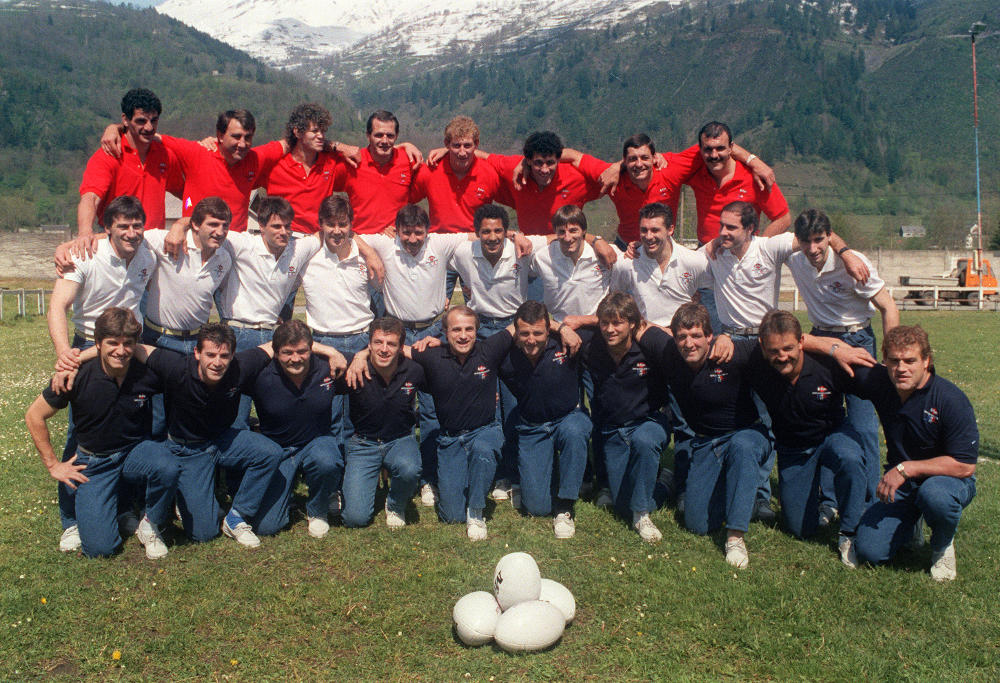
France’s 1987 Rugby World Cup team (JEAN-PIERRE MULLER/AFP/Getty Images)
Michael Lynagh is the only Australian deserving of an honourable mention, because while France played much of the better rugby in the first half, Australia had a half-time lead due not only to Lynagh’s place kicking, but also his tactical play that often gave the Wallabies a territorial advantage.
Peter FitzSimons portrayed the aftermath in the dressing room following Australia’s semi-final loss in Nick Farr Jones: The Authorised Biography.
“The depression was absolute,” Farr-Jones told his biographer FitzSimons, “We knew we had blown it, that there was absolutely nothing to be done.” (FitzSimons: 1993, 151-2)
“Meanwhile, the French squad walked out on to the middle of Concord Oval, with darkness descending, and led their celebrations with song.” (Campese: 2003, 169)
Simon Poidevin was one player who felt that the Wallabies didn’t produce their best performance. (Poidevin and Webster: 1991, 148)
However, these days, Michael Lynagh has offered a different perspective to Poidevin’s, claiming that Australia simply struck a French side having a good day.
“As tough as it was to accept, France did to us what they often seemed to manage in later World Cups: they found a great performance from practically nowhere – one that didn’t correlate with their previous form,” Lynagh concluded. (Lynagh and Eglinton: 2015, 60)
David Campese offered a very circumspect appraisal of the match in his first autobiography.
“I hate losing. I really do – especially in big matches like that World Cup semi-final in 1987 after we had put in so much effort over so long a period of time,” Campese wrote.
“On the other hand, one team has to lose and it was a great game, one of the best anyone could recall. Surely that had to be some consolation?” (Campese and Bills: 1991, 134)
Today the brilliant semi-final played between Australia and France serves as a reminder of how far the Rugby World Cup has come.
“In 1987, there were just 18,000 people to watch us lose, at the death,” David Campese recollected in 2003, “a Test match still hailed as one of the greatest ever played.” (Campese: 2003, 166)
Bibliography
Campese, David, Bills, Peter. On a Wing and a Prayer. Queen Anne. 1991.
Campese, David. Campo: Still Entertaining. Flick Pass Productions. 2003.
Derriman, Philip. The Rise and Rise of Australian Rugby. ABC Books. 2003.
Dwyer, Bob. The Winning Way. Rugby Press. 1992.
FitzSimons, Peter. Nick Farr-Jones: The Authorised Biography. Random House Australia. 1993.
Lynagh, Michael, Eglinton, Mark. Blindisded: A rugby great confronts his greatest challenge. HarperCollins. 2015.
Poidevin, Simon, Webster, Jim. For Love Not Money. ABC Enterprises. 1991.
Slack, Andrew. Noddy: The Authorised Biography of Michael Lynagh. William Heinemann Australia. 1995.